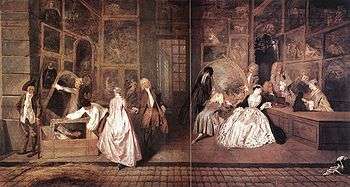Edme-François Gersaint

Edme-François Gersaint (1694–1750) was a Parisian marchand-mercier who was a central figure in the development of the art market and the luxury trades during the era of the Régence and the rule of the rococo style. His shadowy figure has always been connected with his caring friendship with the dying Antoine Watteau, which resulted in the familiar shop sign painted in 1720, conserved at Charlottenburg, a masterpiece that provided publicity for Watteau as much as for Gersaint himself, but he had to wait until 2002 for his first in-depth biography.[1] For his whole career, Gersaint presided from his cramped boutique, hardly more than a permanent booth with a little backshop, on the medieval Pont Notre-Dame, in the heart of the heart of Paris, both creating and following fashion as he purveyed works of art and luxurious trifles to an aristocratic clientele, an artistic creator in his own way.[2]
Gersaint was from a Burgundian merchant family recently settled in Paris. He began his career in 1718, purchasing the stock-in-trade and inheriting the clientele of a picture dealer on the Petit Pont, Antoine Dieu Au Grand Monarque, with a modest capital.[3] Two inventories of his stock, taken in 1725 and 1750, revealed to his biographer, Guillaume Glorieux, the extent to which Gersaint's concerns had broadened, to concentrate as much on exotic novelties, oriental lacquer and porcelain, tea and coffee equipages, shells from tropical seas, as on the presentation of paintings, cleaned and stylishly framed, and mirrors, during decades when Paris regarded itself as the center of civilization.
Starting in 1733, Gersaint compiled catalogues for auction sales in Paris, notably the collections of Quentin de Lorangère (2 March 1744), Antoine de la Roque (22 April 1745), and Angran, vicomte de Fonspertuis (17 December 1747); artists' biographies were appended to Gersaint's extended descriptions of their work.[4] Gersaint's Catalogue raisonné de toutes les piėces qui forment l'oeuvre de Rembrandt (published posthumously, Paris, 1751), was the first catalogue raisonné of a single artist's graphic work, addressing at length the connoisseurship issues in distinguishing Rembrandt's work from that of his pupils in a chapter on doubtful attributions.[5]
Notes
- ↑ Of the enseigne, "Elle ne fait pas publicité de Gersaint, mais celle de Watteau", Daniel Roche observes in his preface to Guillaume Glorieux's monograph, À l'Enseigne de Gersaint: Edme-François Gersaint, marchand d'art sur le Pont Notre-Dame, Paris, 2002; of Gersaint, Glorieux remarks at the outset, "immortalisé par le chef-d'oeuvre de Watteau, Gersaint est célèbre mais on ne sait presque rien de lui."
- ↑ "Gersaint, faiseur de modes, suiveur de modes, est, d'une autre façon que Watteau, un créateur vrai", remarks Daniel Roche in his preface to Glorieux 2002:v.
- ↑ Glorieux 2002:28ff; the Petit Pont lined with shops, burned that same year and Gersaint removed to the Pont Notre-Dame.
- ↑ Holm Bevers, Drawings by Rembrandt and his pupils: telling the difference2010:34.
- ↑ Mariẽt Westermann, Rembrandt (2000:321); Bevers 2010.
|